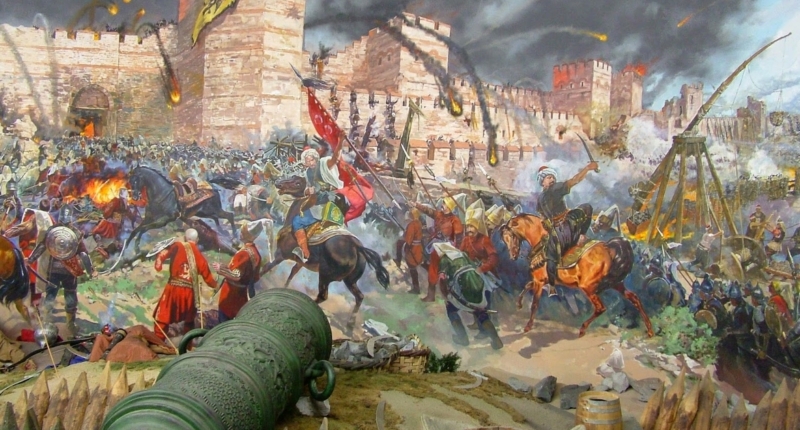Constantinople, the capital of the Byzantine Empire, was captured by the Ottoman Empire in 1453. The Byzantine defenders were heavily outnumbered, and despite having some of the best defensive walls at the time, were ultimately unable to hold off the Ottoman invasion. The Ottomans made many preparations prior to the siege, including building two fortresses to block vital sea routes and improving the roads to transport their siege weapons effectively. Mehmed II led the Ottoman forces, which comprised 75,000 soldiers, 1,500 Serbian cavalry, and 100 ships, against the city. The Ottomans’ cannons and bombards relied on gunpowder, a relatively new aspect of warfare that was revolutionizing medieval combat tactics. Although some strategies may have helped Constantinople to strengthen its defenses or seek allies, it is unlikely that any of these would have been enough to prevent the city’s fall. Mehmed II was a pragmatic ruler who was willing to negotiate with his enemies, but the Byzantine Empire did not have a reputation for political skill or diplomatic finesse at the time.
The Fall of Constantinople: Understanding the Factors Behind the Inevitable Outcome
The fall of Constantinople to the Ottoman Turks in 1453 marked the end of the Byzantine Empire and the beginning of the Ottoman Empire. The event was the culmination of complex political, economic, and military factors that had been building for centuries. Could Constantinople have been saved, and could Byzantium have survived 1453?
The Weakening of the Byzantine Empire
By the 14th century, the Byzantine Empire was in a state of decline, with a weakened economy, a corrupt bureaucracy, and internal divisions. This made it increasingly vulnerable to external threats such as the Ottoman Turks who were steadily expanding their territory in Anatolia.
Shifting Balance of Power in Europe
The Byzantine Empire had traditionally relied on alliances with Western powers, particularly Venice and Genoa, to maintain its position in the region. However, by the 15th century, these powers were beginning to decline, and new players such as the Ottoman Turks were emerging as major regional powers. This left the Byzantine Empire increasingly isolated and vulnerable.
The Formidable Ottoman Turks
Under the leadership of Mehmed II, the Ottoman Turks were a significant factor in the prelude to the invasion. They were a formidable military force that had already conquered much of Anatolia and the Balkans. Mehmed II became determined to capture Constantinople and saw it as a symbol of his power and prestige. To achieve this goal, he assembled a massive army and invested heavily in advanced siege technology such as cannons and artillery.
The Political Situation in Constantinople
In 1453, the city was ruled by Emperor Constantine XI, who was facing significant challenges both from within and outside the city. The city’s defenses had fallen into disrepair, and its population had become depleted by years of war and disease. Moreover, the emperor faced opposition from within his own court, with many of his advisors advocating surrender to the Ottomans.
Conclusion
In conclusion, the fall of Constantinople was not an isolated event, but the inevitable outcome of centuries of decline and external pressures. Although various factors may have played a role in the city’s ultimate defeat, it was ultimately the combined strength of the Ottoman Turks and the weakness of the Byzantine Empire that led to its downfall. Despite the efforts of some brave individuals, Constantinople could not have been saved, and Byzantium could not have survived the overwhelming force of the Ottoman Turks.
Could Constantinople Have Been Saved? Exploring Strategies to Prevent Its Fall
Constantine XI Palaiologos was determined to defend Constantinople against the Ottoman Turks. Despite seeking help from Western powers and ordering repairs to the city’s defenses, the efforts were ultimately insufficient to withstand the Ottoman attack. In May 1453, Mehmed II launched a massive assault on the city, using advanced siege technology to breach the city’s walls and capture the city.
However, the question remains: was there a way that Constantinople could have withstood the Turks? In this essay, we will explore the factors that led to the fall of Constantinople and consider whether there were any strategies that could have prevented it.
Facing a Formidable Opponent
Firstly, it is important to note that Constantinople was facing a formidable opponent in the Ottoman Turks. The Ottomans had a powerful army and were experienced in siege warfare. They also had access to advanced siege technology, such as cannons and artillery, which gave them a significant advantage over the defenders of Constantinople. Moreover, the Ottomans had a determined leader in Mehmed II, who was set on capturing the city at any cost.
Strengthening the Defenses
One possible strategy that Constantinople could have employed was to strengthen its defenses. The city was surrounded by massive walls and fortifications, but these had not been maintained or upgraded in centuries. If the Byzantine Empire had invested in repairing and upgrading its defenses, it could have made it much more difficult for the Ottomans to breach the city’s walls. However, even with stronger defenses, Constantinople would still have been vulnerable to the Ottomans’ advanced siege technology, and it is unlikely that this strategy alone would have been enough to prevent the city’s fall.
Seeking Allies
Another strategy that Constantinople could have employed was to seek allies to help defend the city. The Byzantine Empire had allies in Europe, and if it had been able to secure the support of countries like Hungary or Venice, it might have been able to repel the Ottoman attack. However, the Byzantine Empire was weakened by internal divisions and political instability, which made it difficult to form alliances or even to mobilize its own forces effectively.
Negotiating a Peace Agreement
A third strategy that Constantinople could have employed was to negotiate a peace agreement with the Ottomans. This would have required a significant compromise on the part of the Byzantine Empire, but it could have prevented the city’s fall and the subsequent loss of life and destruction. However, it is uncertain whether the Ottomans would have been willing to negotiate such an agreement, given their desire to capture the city and their perception of the Byzantine Empire as a weak and vulnerable state.
Conclusion
In conclusion, the fall of Constantinople was the culmination of complex factors that had been building for centuries. While there were potential strategies that Constantinople could have employed to prevent its fall, such as strengthening its defenses, seeking allies, or negotiating a peace agreement with the Ottomans, it is uncertain whether any of these strategies would have been successful. Ultimately, Constantinople was unable to withstand the overwhelming force of the Ottoman Turks, and the fall of the city marked the end of the Byzantine Empire.
The Fall of Constantinople: Could Negotiation Have Saved the City?
Mehmed II, the leader of the Ottoman Turks, was known for his pragmatic approach to ruling and was willing to negotiate with his enemies. If the Byzantine Empire had been willing to cede some territory or pay a ransom, it might have been able to avoid a full-scale siege of Constantinople. However, negotiating with the Ottomans would have required a significant amount of political skill and diplomatic finesse, which the Byzantine Empire did not have a reputation for at the time.
In 1453, Constantinople was heavily defended with the Theodosian Walls, which were some of the best defensive systems of the time. However, the Ottoman army, comprising 75,000 soldiers and Janissaries accompanied by siege weapons, 1,500 Serbian cavalry, and 100 ships, laid siege to the city on April 6th, and captured it after 53 days. The Ottoman Empire was a formidable enemy with a significant advantage in terms of military technology and resources.
The fall of Constantinople was a significant event in the history of the Byzantine Empire, marking the end of the Roman Empire. The prelude to this event was a complex mix of political, economic, and military factors that had been building for centuries. The Byzantine Empire was in a state of decline, with a weakened economy, a corrupt bureaucracy, and internal divisions, making it increasingly vulnerable to external threats, such as the Ottoman Turks who were steadily expanding their territory.
In addition to the weakened state of the Byzantine Empire, the shifting balance of power in Europe also played a significant role in the lead-up to the invasion. The Byzantine Empire had traditionally relied on alliances with Western powers, particularly Venice and Genoa, to maintain its position in the region. However, by the 15th century, these powers were beginning to decline, and new players such as the Ottoman Turks were emerging as major regional powers, leaving the Byzantine Empire increasingly isolated and vulnerable.
The use of Greek fire by the Byzantine Navy during the Byzantine-Arab Wars was a significant advantage in sea battles, but it was ultimately insufficient to withstand the Ottoman assault on Constantinople. The city’s defenses had fallen into a state of disrepair, and its population had become depleted by years of war and disease. Emperor Constantine XI faced opposition from within his own court, with many of his advisors advocating surrender to the Ottomans.
In conclusion, while negotiation with the Ottomans might have been a viable strategy to avoid the siege of Constantinople, it is unlikely that any strategy would have been enough to prevent the city’s fall. The Ottoman Empire was simply too powerful and determined, and the Byzantine Empire was too weakened by internal divisions to mount an effective defense. Nonetheless, the legacy of Constantinople lives on, and the city’s rich cultural heritage continues to inspire and captivate people around the world.
The Siege of Constantinople is regarded as one of the most significant events in medieval history. It marked the end of the Byzantine Empire and the rise of the Ottoman Empire. The Ottomans were equipped with advanced military technology, including powerful cannons and bombards that relied on gunpowder. These weapons could literally blow away castle walls, making the medieval combat tactics obsolete.
Outnumbered and Outgunned
The Ottoman forces heavily outnumbered the defenders of Constantinople, which were only 10,000 men strong with 26 ships. The Byzantine Empire was in a weakened state and the city of Constantinople was in poor shape. The Black Death had halved the population just a century ago, and the waning influence of the Byzantine Empire meant that the inhabitants of the city continued to decline.
Preparations for Siege
Preceding the siege, Mehmed II made many preparations to ensure a successful outcome. Two fortresses were built to block vital sea routes that Constantine XI’s allies were sending vital support to the city. Additionally, the roads to Constantinople were improved so that the Ottoman’s powerful siege weapons could be transported effectively. Mehmed II’s fleet also encircled the city from the sea.
Ottoman Fleet vs Theodosian Walls
The siege began when Mehmed sent his fleet to capture smaller Byzantine strongholds and ordered them to open fire on the walls with cannons. Although Constantinople featured some of the best defensive walls at the time, the defending force only had enough troops to man the outer wall. The Byzantines had cannons in their arsenal, but they weren’t nearly as powerful as those the Ottomans brought along with them.
This didn’t turn out too well for the Ottomans, as not only did their fleet fail to capture the Byzantine castle at Studius, but also the cannons also were doing minimal damage to the Theodosian Walls. Eventually, the Ottoman fleet broke into Byzantine lines, causing heavy casualties.
Mehmed II, having failed in his attempt to break the Golden Horn Chain that guarded the Byzantine harbor with brute force, instead used the same tactic as the Rus’ Khaganate’s siege of Constantinople in 860 AD, towing his ships across Galata over greased logs and into the estuary.
Final All-Out Assault
On land, the Ottomans attempted many unsuccessful frontal charges, which ended in heavy casualties on their part. Eventually, after the Byzantine emperor rejected a surrender offer, Mehmed prepared for a final all-out assault on the city. After 53 days of siege, the Ottomans finally breached the walls of Constantinople and captured the city.
Legacy of the Siege
The fall of Constantinople marked the end of the Byzantine Empire and the beginning of the Ottoman Empire. The Ottoman Empire would go on to become one of the most powerful empires in history, spanning three continents and lasting for over six centuries. The Siege of Constantinople is a significant event in medieval history, marking the end of an era and the beginning of a new one.
On May 29th, the Ottomans targeted a damaged section of the wall at Blacheranae during the Siege of Constantinople. They managed to break through the wall, and the outnumbered defenders couldn’t stop the invading forces. Constantine XI fought in the streets but was ultimately killed, and the city fell to the Ottomans. After three days of plundering and rape, Mehmed ordered his troops to stand down and promised safety to any locals who returned to their houses, though few citizens were still alive. It is a question that has fascinated historians and scholars for centuries whether Constantinople could have been saved, but the city ultimately fell due to the Ottoman Empire’s military power and the weakened state of the Byzantine Empire.
Don’t miss interesting posts on Famousbio










